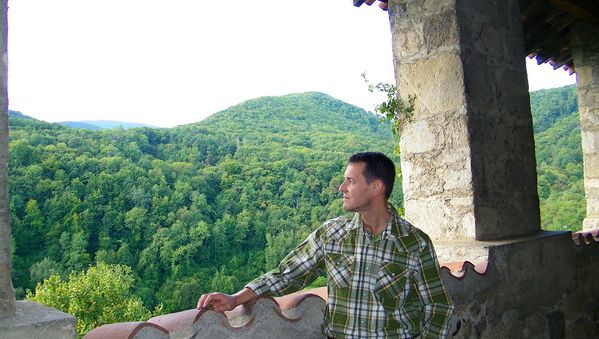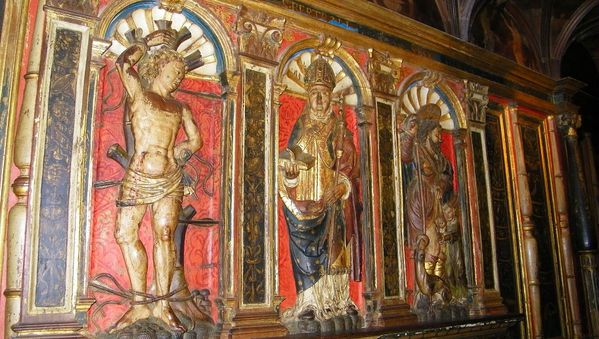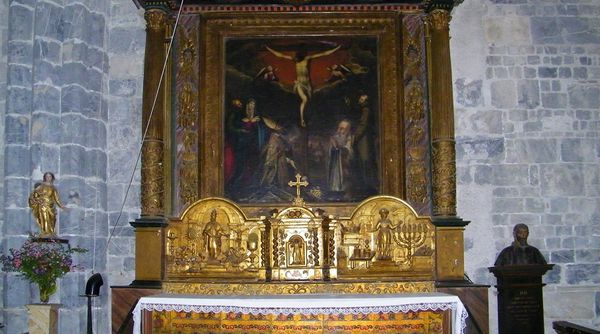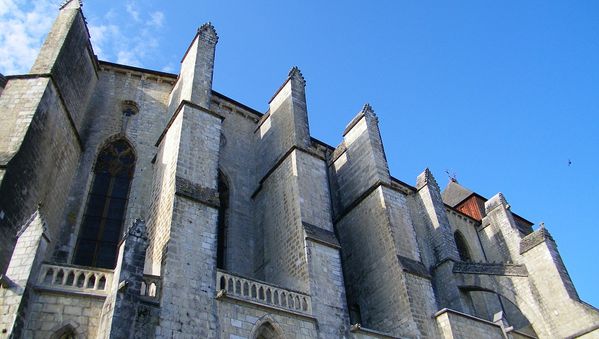October 20 2011
4
20
/10
/October
/2011
07:07
The construction of the cathedral dates back to around the year 1100. Throughout the centuries it has suffered little damage except during the Wars of Religion. Among those who have built, developed and preserved the cathedral are Saint-Bertrand-de-l’Isle, Pope Clement V and Bishop Jean de Mauléon. It is one of the earliest monuments placed on the list of French Historical Monuments in 1840. It rests at the top of a hill overlooking the medieval town with its old stone houses and timber framed buildings. The design is both clever and functional—within one nave and one roof stand three churches of different periods and styles built by different hands. There is the 12th century Romanesque church, a 14th century Gothic church and a 16th century Renaissance church entirely made of wood (also known as the choir and stalls). The tympanum above the entrance shows the adoration of the Magi. Rather than showing Christ in Majesty, it is the Virgin Mary who is seated at an angle and surrounded by adoring angles. The figure on the right is Saint-Bertrand himself giving a blessing. Below on the lintel are carved figures of the twelve apostles. Early in the 14th century, a complete transformation of the old Romanesque building began and the vaulting and part of the nave were demolished. The remainder was integrated into the new church. The cloister was built on the ramparts of the southern side of the church and dates back to the 12th century. It underwent profound alteration several times. Its shape is uneven, as is the ground it is built upon. It consists of four galleries around an open space. Three of the galleries are Romanesque and covered by an openwork frame. Perhaps the most expressive column is the pillar of the four evangelists. The southern gallery has the unique feature of opening out onto the surrounding countryside and views of the mountains. The northern gallery was completely reconstructed in the 15th century and given vaults. It is known as the gallery of tombs because of the tombs and inscriptions that are found here. Inside, the nave is 16 meters wide, rounded at the apse and without aisles or a transept. The radiating side chapels fit in between the exterior buttresses. The cross-ribbed vault is 28 meters high and extends 55 meters from the chevet to the tower. It has a pattern of diagonal arches which intersect at keystones bearing the coat of arms of the benefactors who helped build the cathedral. At the apse, eight ribs splay out from a single keystone to give a harmoniously rounded end to the nave. The walls are of grey stone of the area, in contrast to the red brick used in other cathedrals and churches in the south of France. One high point of the visit is the Canons’ Chancel (a choir and its stalls) which is one of the most beautiful pieces of Renaissance woodworking. Work on this masterpiece was carried out under the patronage of Bishop Jean de Mauléon, who performed the inauguration on Christmas Eve 1535. The carvings include the rood screen, the choir screen, the high altar reredos, a bishop’s throne surmounted by a three-tiered pyramidal dome and 66 stalls, 38 of them with tail backs and canopies. The high altar reredos are of sculpted wood and clustered with small columns, niches, turrets and pinnacles. It was unfortunately spoiled by garish paint and gilt in the 18th century. Two levels of niches contain beautiful religious statues above the high altar. Above sits enthroned the Everlasting Father, with Moses and Elijah on one side and Saint-Peter and Saint-Paul on the other. In the center of the level below; the Virgin and Child rest between statues of Saint-John the Baptist and Saint-Sébastian. Running along the base is a frieze of 27 paintings where 115 characters are used to tell the story of the life of Christ and His mother. The entrance to the choir is preceded by the jube tribune, where two painted panels with polychrome statues are positioned on either side of the entrance. These panels once served as reredos for the parish altars. The panels contain groups of three figures. On the south side, there is the Virgin and Child, in between Saint-John the Baptist and Sainte-Genevieve. On the northern side, Saint-Bertrand stands between Saint-Sébastian and Saint-Roch. These beautiful polychrome sculptures are the only ones of this type in the cathedral. The passage between the chapels and the outside walls of the Renaissance choir is called the ambulatory. It was formerly used by pilgrims, who would make their way around the choir from the jube tribune to the mausoleum of Saint-Bertrand, stopping halfway in front of the openwork balustrades of the sanctuary. In the first half of the 15th century, Bishop Pierre de Foix erected this majestic monument in the middle of the sanctuary to receive and venerate the relics of Saint-Bertrand. It is built in soft stone, with four rectangular sides. The side facing the chevet is covered with scenes painted on the stone in the 17th century showing the miracles performed by the Saint. An altar stands against the side; above, in the center, there is a niche where the head of Saint-Bertrand is preserved inside a silver-plated bust. The side facing the choir has a central cavity containing the great silver and ebony reliquary where Saint-Bertrand’s body lies at rest. The reliquary only leaves the cathedral at the time of the great jubilees (every time the 3rd of May falls on a Friday). As pilgrims continued their way around the choir they would also stop to pray at the 16th century Lady Chapel, notable for its size and its palm shaped vaulting as well as the tomb of Bishop Hugues de Chatillon which stands at the entrance. The tomb is a masterpiece of marble sculpting. The organ case lies outside the choir and was made in the same style. It dates from the 16th century and is raised up on five columns. The top of the organ case is covered with sharp spires and pinnacles and at the foot is a pulpit, facing the parish altar. The original organ must have had 20 or 30 rows of pipes. Today there are 40. It has received major restorations three times: in 1835, 1901 and 1975. The work in 1975 restored to the instrument the tones of a French classical organ for which it had been famous. The parish altar of the Blessed Sacrament juts out into the cathedral and was not part of the original plan. It was added in 1621 by Bishop Gilles de Souvre allowing the general public to participate in church services, rather than merely being able to attend behind the Renaissance choir screen. The sculptures around the tabernacle represent the Old Law as well as the emblems of the new form of Christian worship, a cross, a chalice and a monstrance. In front of the altar there is an example of fine Cordoba leather, painted with the scene of the crucifixion.
Published by The Baguette
-
in
Catholocism

















 The top of the organ case is covered with sharp spires and pinnacles and at the foot is a pulpit, facing the parish altar. The original organ must have had 20 or 30 rows of pipes. Today there are 40. It has received major restorations three times: in 1835, 1901 and 1975. The work in 1975 restored to the instrument the tones of a French classical organ for which it had been famous.
The top of the organ case is covered with sharp spires and pinnacles and at the foot is a pulpit, facing the parish altar. The original organ must have had 20 or 30 rows of pipes. Today there are 40. It has received major restorations three times: in 1835, 1901 and 1975. The work in 1975 restored to the instrument the tones of a French classical organ for which it had been famous.  The parish altar of the Blessed Sacrament juts out into the cathedral and was not part of the original plan. It was added in 1621 by Bishop Gilles de Souvre allowing the general public to participate in church services, rather than merely being able to attend behind the Renaissance choir screen. The sculptures around the tabernacle represent the Old Law as well as the emblems of the new form of Christian worship, a cross, a chalice and a monstrance. In front of the altar there is an example of fine Cordoba leather, painted with the scene of the crucifixion.
The parish altar of the Blessed Sacrament juts out into the cathedral and was not part of the original plan. It was added in 1621 by Bishop Gilles de Souvre allowing the general public to participate in church services, rather than merely being able to attend behind the Renaissance choir screen. The sculptures around the tabernacle represent the Old Law as well as the emblems of the new form of Christian worship, a cross, a chalice and a monstrance. In front of the altar there is an example of fine Cordoba leather, painted with the scene of the crucifixion. 









